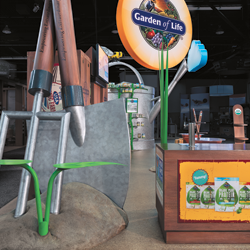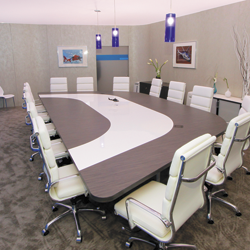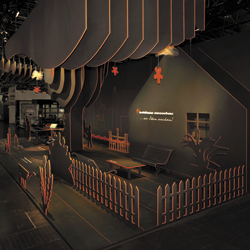|
exhibitor q&a
Help!
Hybrid exhibits
 Q.
More and more I see the term "hybrid" being used to describe exhibits. What does the term really mean?
A.
In the exhibit-marketing industry, few terms are more hyped and less understood than "hybrid." Nearly every exhibit manufacturer and custom builder (my firm included) refers to at least some of their offerings as a type of hybrid, e.g., a portable hybrid, modular hybrid, or even custom hybrid. So why has the term become so popular as of late? It's all about creating the perception of improved value. Exhibitors want displays that do everything. They must assemble quickly, exude a custom aesthetic, weigh practically nothing, and reconfigure into more shapes and sizes than a box of Legos. And up until the last couple of years, a Swiss Army Knife exhibit that met all, or at least most, of these demands was impossible. That's because there used to be just two different types of exhibits: portable/modular displays and custom structures. Portable/modular displays were dominated by pop-ups, panel displays, and modular laminate exhibits. While they had multiple configurations, components, and accessories, they typically offered limited design flexibility. On the other hand, custom exhibits, built primarily from wood, gave exhibitors endless design possibilities but were rarely portable, lightweight, or reconfigurable. Hybrid exhibits merge these two worlds. Although each exhibit house seems to have its own definition of what a hybrid is (and isn't), most comprise aluminum frames and tensioned fabric. That's because tensioned fabric is durable, vibrant, and cost effective. And aluminum is structural, attractive, and lightweight. That's not to say that other material combinations aren't available. Exhibit houses have myriad options and a plethora of materials from which to choose. To illustrate the point, here are some of the more common hybrid options available: There are portable hybrids, comprising an aluminum-extrusion frame and tensioned-fabric graphics. Then you've got modular hybrids, which add modular laminate components. And finally, there are custom hybrids, which combine extrusion with just about anything else, e.g., metal, Plexiglas, wood, glass, and sometimes even other portable or modular systems. Certainly, hybrids may not be the ideal solution for everyone. After all, for many exhibitors, a basic pop-up or a full custom exhibit is an ideal fit for their needs. But when you're looking for that perfect mix of minimal weight, portability, flexibility, and stellar design, a hybrid may be your best bet.
— Mel White, vice president of marketing and business development, Classic Exhibits Inc., Portland, OR
Help Wanted Send your tough questions about exhibiting to Linda Armstrong, larmstrong@exhibitormagazine.com.
|
|
|
||||||||||||||||||||||||||||
|
|
||||||||||||||||||||||||||||
|
TOPICS Measurement & Budgeting Planning & Execution Marketing & Promotion Events & Venues Personal & Career Exhibits & Experiences International Exhibiting Resources for Rookies Research & Resources |
MAGAZINE Subscribe Today! Renew Subscription Update Address Digital Downloads Newsletters Advertise |
FIND IT Exhibit & Display Producers Products & Services All Companies Get Listed |
EXHIBITORLIVE Sessions Certification Exhibit Hall Exhibit at the Show Registration |
ETRAK Sessions Certification F.A.Q. Registration |
EDUCATION WEEK Overview Sessions Hotel Registration |
CERTIFICATION The Program Steps to Certification Faculty and Staff Enroll in CTSM Submit Quiz Answers My CTSM |
AWARDS Sizzle Awards Exhibit Design Awards Portable/Modular Awards Corporate Event Awards Centers of Excellence |
NEWS Associations/Press Awards Company News International New Products People Shows & Events Venues & Destinations EXHIBITOR News |
||||||||||||||||||||
|
||||||||||||||||||||||||||||






